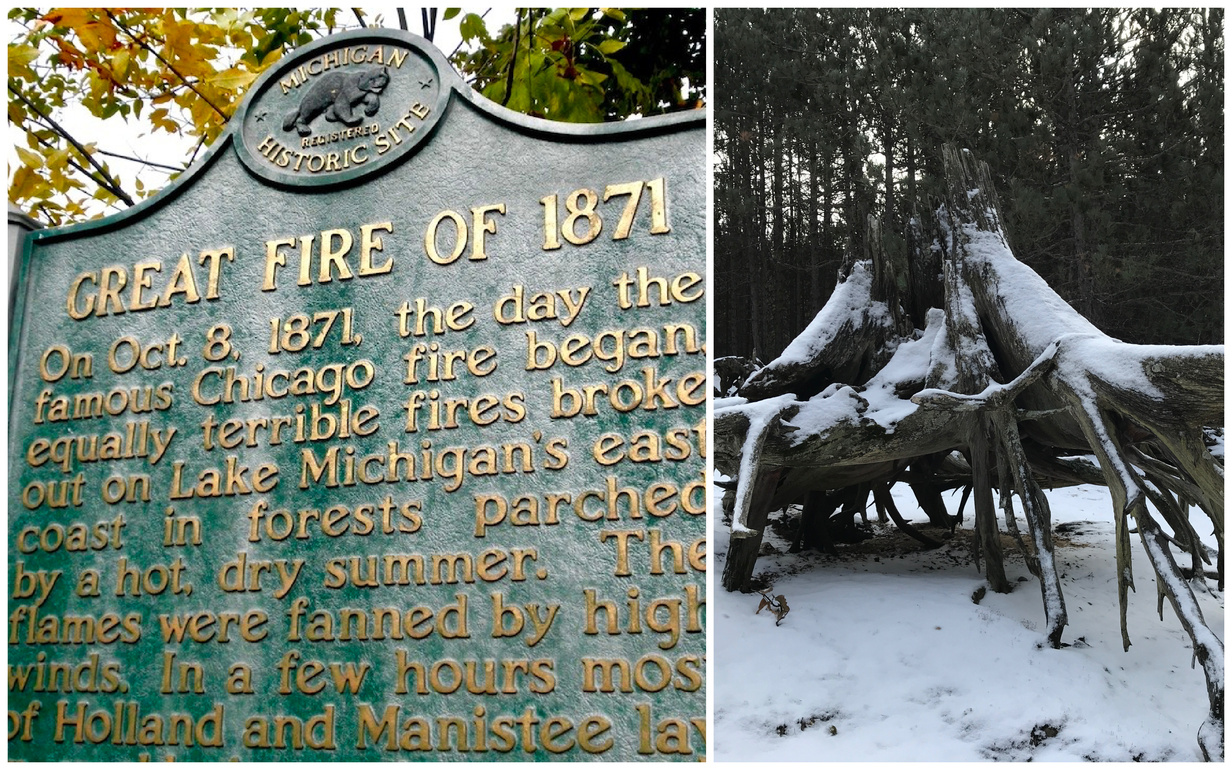
Northern Michigan Has Its Own Wildfire History
By Ross Boissoneau | Jan. 12, 2025
The effects of the fires ravaging Los Angeles will last for decades or longer. As evidence, one need look no further than here in northern Michigan, where fires dating back a century and a half are still impacting the area.
In 1871, a massive swath of fires devastated the Midwest, with the Great Chicago Fire, the Peshtigo Fire and the Great Michigan Fire charring millions of acres and claiming thousands of lives. While the Grand Traverse area was largely spared, areas as close as Manistee were practically burned to the ground. The Great Michigan Fire burned some 2.5 million acres, making it the third-largest U.S. wildfire ever.
But earlier fires had already begun transforming the area. Dr. Kurt Kipfmueller, professor of geography, environment, & society at the University of Minnesota, says the Fife Lake area shows such evidence.
Kipfmueller grew up in Michigan and returns to his family cottage in Fife Lake every summer. During the pandemic, it’s where he and his family were sequestered, so he began studying the forest he’d grown up around.
“Fires were lots more frequent in the past, more than you’d expect from natural causes,” he says. “It was used as a management tool by the indigenous groups.” Both the Native Americans and the settlers that came in used fire to clear land. He says fires helped keep sightlines open and provided room for trails through the woods, as well as providing open space to plant staples, including blueberries.
“Public land surveys in the 1830s show no trees – they were already burned. Fire in the northern lower peninsula is an important part of the ecological and cultural side of things,” says Kipfmueller, who also authored a 2019 report to the Sleeping Bear Dunes National Lakeshore on the fire history of two coastal red pine forests in Sleeping Bear Dunes National Lakeshore.
Such fires also removed some of the impediments for other species to thrive, according to Lynn Bakker, forester and forest ecologist with Bakker Forestry in Suttons Bay. “Aspen need sunshine. Jack pine need sunshine,” she says.
The clear-cutting of white pines and previous fires had already begun transforming the forest areas. “Anytime you have a major event like that – fire, wind like in 2015, clear-cut logging – it will change the tree composition,” says Zack Crawford, owner of Crawford Forestry & Land Management in Lake Ann. With the loss of the white pine forests, in came the early adapters. “You got early successional species,” he says, including aspen, cherry and jack pine.
Fire is doubly important for jack pine: Its cones actually depend upon high heat to open and release the seeds. The resin that seals the cones melts when the temperature reaches 122-140 degrees, releasing the seeds, which germinate in the burned soil.
But if hot enough, fire can even damage the soil. Liam Daniels, soil scientist for the Missaukee Conservation District, says he believes the Great Fire dealt the state’s soil a blow it still hasn’t recovered from. “The quality of our soil now .... it’s not very fertile. How much (is) from the fire – you can’t place a finger on it exactly. But it’s sure different compared to 150 years ago.”
He cites three effects. “Past a certain heat, the organic matter will burn off,” he says. Secondly, “The products of combustion make it particularly hydrophobic – it repels water.” Third, he says the destruction of the soil’s structure leaves it prone to compaction. “The burning of organic matter in soil creates voids,” he says. “Soil becomes more compacted.”
Not everyone agrees. “Soils in Michigan are sandy loess, windblown deposits (with) poor nutrient. I don’t think our soil quality is related” to fires, says Kipfmueller.
Adam Brown, agricultural program coordinator at the Grand Traverse Conservation District, notes that plants and soil are both resilient. “The composition (of the soil) is set by the alluvium,” he says, the mix of clay, silt, sand and or gravel deposited thousands of years ago by the glaciers.
“Fire effect is short term,” Brown continues. “Plants show up – you may call them weeds. Trees like jack pine – their seeds only grow after a fire. It also puts carbon in the soil. It depends on how hot it is.”
Bakker agrees the level of heat is of particular importance. “Some areas came back fairly successfully. The fires weren’t as hot,” Bakker says. Elsewhere it was a different story. “The areas (that) were cut and cut over … it burned so hot nothing grew there,” she says.
Perhaps time has helped people learn – relearn – how to both provide room for new species while mitigating the hazard of huge conflagrations. One method used to prevent raging fires such as those of 1871 is managed burns. Foresters and groups including the National Park Service use carefully managed fires to provide opportunities for growth and even the removal of undesirable species. “Prescribed burns, not clear-cut as 100 years ago, but managed by us, are not as hot,” Bakker says. “They don’t burn the topsoil.”
They can provide the heat necessary to spread seeds for the likes of jack pine, and at the same time also prevent the over-accumulation of dried brush and other fuel.
A bonus: “They remove invasives like autumn olive and ailanthus,” says Bakker.
Comment






